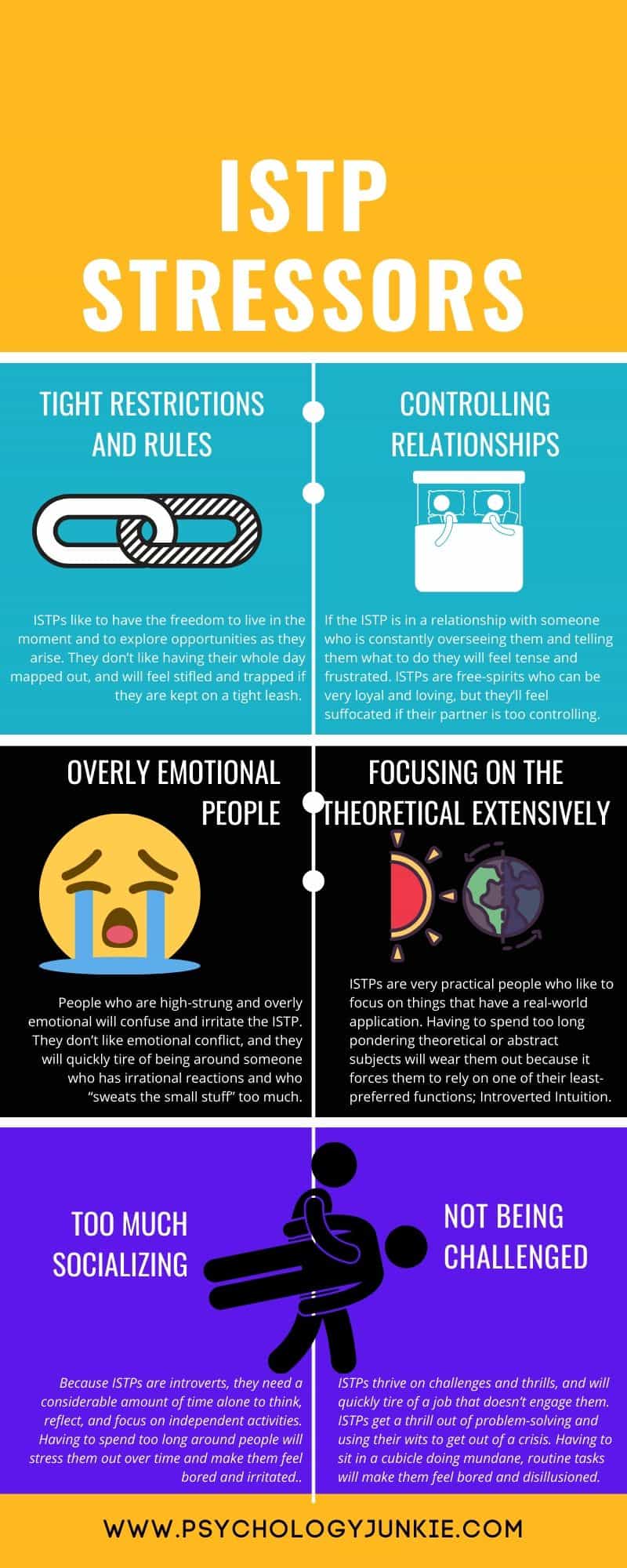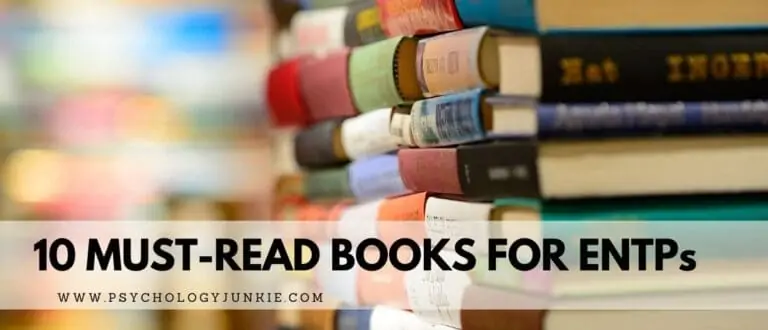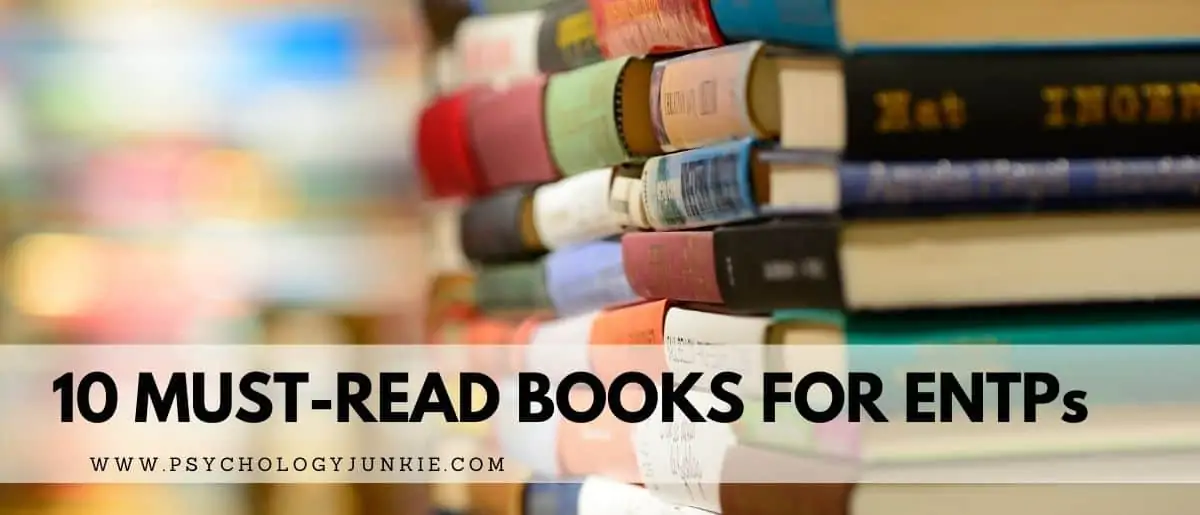10 Signs of an Unhealthy ISTP
Have you ever met an ISTP who was constantly dismissing your views, arguing with you over every little detail, or saw every sign of emotion as a sign of weakness? Maybe you known an ISTP who is reclusive, shut off from people, and absorbed in their own world.
Some people have bad interactions with a particular type and then assume that everyone with that personality type is the same way. This is one of the reasons that Facebook groups about personality are often rife with stereotypes, misunderstandings, and hurtful judgments. But the truth is, we all have moments in our lives where we are operating in an unhealthy or immature way. We all have bad days and good days. I’ve written in depth about many of the Myers-Briggs personality types and how they can show up in negative or positive ways, and today we’re going to explore the unhealthy ISTP.

What makes ISTPs unhealthy? How do they typically react when they’re having an immature moment? How can they cope?
Let’s get started!
Not sure what your personality type is? Take our new personality questionnaire here. Or you can take the official MBTI® here.
Table of contents
Estimated reading time: 10 minutes
How Do ISTPs Become Unhealthy?

Stress:
One of the most common triggers for unhealthy or immature behavior in ISTPs is stress. Typically known for their cool-headedness, logic, and realism, ISTPs are happiest in environments where they can have freedom and pursue life with openness and curiosity. But even the most stoic of ISTPs can be destabilized by ongoing chronic or intense stress, forcing them out of their natural mode of competence and calm.
When ISTPs are going through a lot of ongoing, overwhelming stress, they can experience what’s called “the grip.” This is when ISTPs fall into the grip of their inferior function, Extraverted Feeling (Fe). This is a particularly disorienting experience for ISTPs, who are more comfortable dealing with facts and logic than charging into emotional territory.
When ISTPs are in the grip of Extraverted Feeling, they become overwhelmed with big emotions. They can’t think as clearly as usual, or as logically. Often they start to second-guess their relationships, worry that people don’t like them anymore, or fear that they have no social standing or friends.
Here’s an example: An ISTP, let’s call him Bob, is going through a divorce. His wife has been constantly berating him, criticizing his every move, and is trying to turn his children against him. Bob is in a highly emotional state, feeling completely overwhelmed by the situation. Normally very confident and sure of himself, he starts to doubt his own abilities and decisions. He becomes hypersensitive to criticism, can’t stop ruminating about what went wrong, and feels like a total failure. Normally he’s independent, reasonable, and cool-headed. Now he feels overwhelmed with emotions, worried that nobody likes him, and anxious to feel close to someone – to have friendship, connection, and solidarity. He might erupt more in emotional outbursts or find himself crying over insurance commercials on television.
In this situation, Bob is experiencing chronic, intense stress, and his Thinking and Sensing sides are overwhelmed. He’s in the grip of his Feeling side and it’s making him feel totally unlike himself. If you were to meet him now, he wouldn’t seem like the stereotypical ISTP. He’d seem insecure, emotional, demonstrative, eager for connection or hiding himself away so that nobody could witness his emotional state.
Imbalance:
Now let’s look at another way that ISTPs can become unhealthy: Imbalance. This happens when a person has leaned into certain personality strengths while completely ignoring or devaluing others.
This is the ISTP who’s deeply logical and analytical, but who never leaves his home.
This could be the ISTP who wins in an argument but has no friends and thinks it’s everyone else’s fault because they’re too “sensitive.”
This could be the ISTP who is realistic, grounded, and matter-of-fact, but who lacks a sense of deeper meaning and feels hungry for it.
Sometimes we lean into our strengths and never try to work on our weaknesses. Some people are raised in families where certain strengths are admired and others are not, so they grow up leaning into one part of themselves while cutting off another part of themselves.
Some people are coddled for their personalities; praised and revered. Others are berated, criticized, and stifled and so they try to minimize their strengths and lean into their weaknesses (resulting in stress).
There are many factors that contribute to someone being imbalanced, and these are just a few. But these can significantly contribute to the way in which an ISTP shows up in the world.
10 Signs That You’re Dealing with an Unhealthy ISTP
1. Thrill-Seeking Escalates to Risky Levels
It’s no secret that ISTPs live for the thrill of the moment, often finding joy in adrenaline-pumping activities. However, when this thrill-seeking crosses into risky behavior with little regard for their well-being or that of others, it’s a sign something’s not right. Usually it means they need to get more in touch with the introverted part of their personality. Some ISTPs get into this impulsive streak when they’re feeling overwhelmed by external obligations and demands and can’t get enough time to recharge alone.
2. A Surge of Unexplained Anger
A typically calm ISTP veering into bouts of intense anger, especially over small things, raises red flags. When every little thing starts to get under their skin, it’s an indicator of deeper frustrations bubbling below the surface.
3. Withdrawing from the World
An ISTP turning reclusive isn’t unusual—they value their alone time. Yet, there’s a thin line between seeking solitude and cutting off the world. When an ISTP retreats into their shell, avoiding interaction and activity, it’s a sign that they may be entering a Ti-Ni loop. During these moments, they tend to become more detached from reality than is typical. You can find out more about the Ti-Ni Loop in this article.
4. An Overblown Ego Defense
Nobody likes to be wrong, but ISTPs can take it to another level when unhealthy. They start playing ego defensive survival games, unable to accept they might not always be the most capable person in the room. They start to pick on someone’s choice of words and lose the main point by splitting hairs over details.
5. Critical of Everything and Everyone
It’s healthy to question things, but unhealthy ISTPs take this to an extreme, critiquing everything and everyone around them. This incessant need to find fault in others often masks their insecurities, pushing people away in the process. This usually results from an ISTP having an imbalanced, warped personality. ISTPs like this might have leaned too heavily on their Thinking side, without developing their other cognitive functions. This might be a sign that the ISTP needs to explore their Sensing side, or even their Feeling side.
Even though ISTPs are Thinking-dominant types, they still have a feeling side. Learning to tap into Extraverted Feeling, even for very small amounts of time, can help them to soften this critical edge to their personality.
6. Pessimism About the Future
Average to healthy ISTPs are fairly optimistic and resilient. But an ISTP in a Ti-Ni loop becomes pessimistic and gloomy, seeing the future as full of foreboding doom. This pessimism can show up as as a lack of motivation for future plans or projects and an overall sense of dread toward what lies ahead.
For ISTPs:
Getting out of this doom-and-gloom mindset involves getting in touch with the extroverted side of your personality type as an ISTP. This doesn’t mean going out and being in a giant crowd of people, though! It means spending time in nature, getting active, going out with one or two friends you enjoy, or even spending time with a pet! As you break out of your shell a little, it becomes easier for you to slide back into your more realistic, observant, resourceful perspective.
7. Seclusion as a Defense Mechanism
To avoid feeling restricted or trapped, unhealthy ISTPs may cut off relationships and retreat into themselves. I once knew an ISTP who became a hermit and shut himself away from everyone for months at a time. Instead of fulfilling relationships, he became obsessed with endless online arguments on forums. He lost touch with that adventurous, outdoorsy side of himself and became deeply unhappy and lost. Thankfully, he eventually came out of this stage with some professional help, but this is a common sign that an ISTP is drifting into a Ti-Ni loop.
8. Obsessive Detail Orientation
While paying attention to detail is admirable, obsessing over every little aspect, often at the cost of the bigger picture, is a sign of an ISTP losing balance. They might begin projects with fervor, only to get bogged down by minutiae, eventually leaving the project half-done. It’s crucial for ISTPs to take breaks and get out of their heads, reassessing the end goal they really want to achieve.
9. Leaping Before They Look
ISTPs tend to be on the impulsive side, but this usually comes with a steady sense of logic, facts, and practicality. But ISTPs who are unhealthy tend to jump right into things without taking time for analysis. They might spend money impulsively, take physical risks that later backfire, or make split-second relationship decisions, only to regret them later. This is a sign that the ISTP is out of touch with the introverted side of their personality and is becoming overly focused on the Extraverted Sensing side of themselves. This side of themselves is all about acting on impulsive, living in the moment, taking advantage of opportunities. But when it isn’t tempered by Thinking, it can become out of control and lead to overly-reckless decisions.
10. Sudden Insecurity and Neediness
It’s a bit of a curveball to see ISTPs, who are typically the epitome of cool, self-reliant types, suddenly displaying signs of insecurity and neediness. This can happen when they’re under a heap of stress and find themselves in the grip of their inferior function, Extraverted Feeling (Fe). Normally, ISTPs are more about action than emotion, but when their Fe takes the driver’s seat, it can feel like an emotional rollercoaster that they didn’t sign up for.
Experiencing this doesn’t mean an ISTP has lost their way; it’s just a signal that they’re out of balance. Suddenly, they might find themselves craving validation and support, feeling a bit more vulnerable than usual. This is their system’s way of hinting that they need to rebalance their emotional and psychological well-being.
Getting Help: The first step towards getting back on track is acknowledging these feelings without judgment. Recognizing that it’s okay to be needy once in a while can be liberating. Opening up to trusted friends or family about these feelings can be a huge relief and offer a dose of perspective. If the feelings seem overwhelming, speaking to a mental health professional can provide strategies to manage stress and anxiety, helping to avoid being gripped by inferior Fe in the future.
For ISTPs, it’s also helpful to get away from everyone for a little while and find balance. Practice deep breathing, visualization, or other mindfulness techniques. Play a game of solitaire while breathing deeply to tap back into the thinking and sensing side of your personality type. You can find more ways to reduce stress, specific for your personality type, here: What ISTPs Do When They’re Really Stressed Out
What Are Your Thoughts?
Noticing these signs in yourself or an ISTP you know isn’t a cause for alarm but rather a call to action. It’s about recognizing the detour and gently steering back onto the path towards a balance mindset. We all have days when we’re not at our best, weeks even where stress seems insurmountable. You are not alone and you are not BAD because of these unhealthy episodes. You may just need to figure out some ways to minimize stress, find balance, and get the support you need.
Do you have any extra advice to share with fellow ISTPs? Let us and other readers know in the comments!
 References:
References:
Understanding Yourself and Others™: Exploring Essential Motivators by Linda V. Berens (Interstrength, 2019)
MBTI® Manual – A Guide to the Development and Use of the Myers-Briggs Type Indicator® Instrument by Isabel Briggs -Myers, Mary H. McCaulley, Naomi L. Quenk, and Allen L. Hammer (CPP, Inc. 2003)
Psychological Types by C.G. Jung (1971, Princeton University Press)














Gee, I think I hit all 10. This is what I get for having a micromanaging OCD ISTJ as a wife.